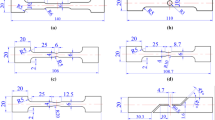Abstract
This paper is a contribution to the prediction of edge fracture behavior using uncoupled ductile fracture models. A fully integrated simulation framework for the edge fracture prediction is proposed with the shear-induced pre-damage considered. User-defined material subroutines are coded with uncoupled ductile fracture models (Lou-Huh, Oh, Brozzo) incorporated, which are calibrated using the fracture strains of various loading paths. A series of 3D numerical simulations are performed and compared with the results of hole-expansion tests. The effects of pre-damage field and fracture models are analyzed and discussed.











Similar content being viewed by others
References
K. Wang, M. Luo, T. Wierzbicki, Experiments and modeling of edge fracture for an AHSS sheet. Int. J. Fract. 187, 245–268 (2014)
X. Wu, H. Bahmanpour, K. Schmid, Characterization of mechanically sheared edges of dual phase steels. J. Mater. Process. Technol. 212, 1209–1224 (2012)
T. Matsuno, J. Nitta, K. Sato, M. Mizumura, M. Suehiro, Effect of shearing clearance and angle on stretch-flange formability evaluated by saddle-type forming test. J. Mater. Process. Technol. 223, 98–104 (2015)
Z.K. Teng, X.M. Chen, Edge cracking mechanism in two dual-phase advanced high strength steels. Mater. Sci. Eng. A 618, 645–653 (2014)
M.D. Taylor, K.S. Choi, X. Sun, D.K. Matlock, C.E. Packard, L. Xu, F. Barlat, Correlations between nanoindentation hardness and macroscopic mechanical properties in DP980 steels. Mater. Sci. Eng. A 597, 431–439 (2014)
V. Uthaisangsuk, U. Prahl, W. Bleck, Stretch-flangeability characterisation of multiphase steel using a microstructure based failure modelling. Comput. Mater. Sci. 45, 617–623 (2009)
P. Sartkulvanich, B. Kroenauer, R. Golle, A. Konieczny, T. Altan, Finite element analysis of the effect of blanked edge quality upon stretch flanging of AHSS. CIRP Ann. Manuf. Technol. 59, 279–282 (2010)
K. Wang, L. Greve, T. Wierzbicki, FE simulation of edge fracture considering pre-damage from blanking process. Int. J. Solids Struct. 71, 206–218 (2015)
C. Ye, J. Chen, C. Xia, X. Yu, Study of curvature and pre-damage effects on the edge stretchability of advanced high strength steel based on a new simulation model. Int. J. Mater. Form. 9, 269–276 (2016)
Z. Marciniak, K. Kuczyński, Limit strains in the processes of stretch-forming sheet metal. Int. J. Mech. Sci. 9, 609–620 (1967)
X. Yu, J. Chen, J. Chen, Interaction effect of cracks and anisotropic influence on degradation of edge stretchability in hole-expansion of advanced high strength steel. Int. J. Mech. Sci. 105, 348–359 (2016)
X. Hu, X. Sun, S.F. Golovashchenko, An integrated finite element-based simulation framework: from hole piercing to hole expansion. Finite Elem. Anal. Des. 109, 1–13 (2016)
Y. Bai, T. Wierzbicki, Application of extended Mohr–Coulomb criterion to ductile fracture. Int. J. Fract. 161, 1–20 (2010)
Y. Lou, J.W. Yoon, H. Huh, Modeling of shear ductile fracture considering a changeable cut-off value for stress triaxiality. Int. J. Plast. 54, 56–80 (2014)
Y. Lou, H. Huh, Evaluation of ductile fracture criteria in a general three-dimensional stress state considering the stress triaxiality and the lode parameter. Acta Mech. Solida Sin. 26(6), 642–658 (2013)
Y. Lou, H. Huh, S. Lim, K. Pack, New ductile fracture criterion for prediction of fracture forming limit diagrams of sheet metals. Int. J. Solids Struct. 49, 3605–3615 (2012)
S.I. Oh, C.C. Chen, S. Kobayashi, Ductile fracture in axisymmetric extrusion and drawing—part 2: workability in extrusion and drawing. J. Engl. Ind. 101, 36–44 (1979)
P. Brozzo, B. DeLuca, R. Rendina, A new method for the prediction of formability in metal sheets. in Proceedings of the 7th Biennial Conference of IDDRG on Sheet Metal Forming and Formability, 1972
C.C. Roth, D. Mohr, Ductile fracture experiments with locally proportional loading histories. Int. J. Plast. 79, 328–354 (2016)
Acknowledgments
Financial support from China Scholarship Council (No. 201506460060) is gratefully acknowledged. Thanks are also extended to Dr. Zhiqiang Sheng at University of Michigan, Professor Taylan Altan and Professor Farhang Pourboghrat at The Ohio State University for their helpful discussions.
Author information
Authors and Affiliations
Corresponding authors
Rights and permissions
About this article
Cite this article
Mu, L., Wang, Y., Zang, Y. et al. Edge Fracture Prediction Using Uncoupled Ductile Fracture Models for DP780 Sheet. J Fail. Anal. and Preven. 17, 321–329 (2017). https://doi.org/10.1007/s11668-017-0245-z
Received:
Published:
Issue Date:
DOI: https://doi.org/10.1007/s11668-017-0245-z




